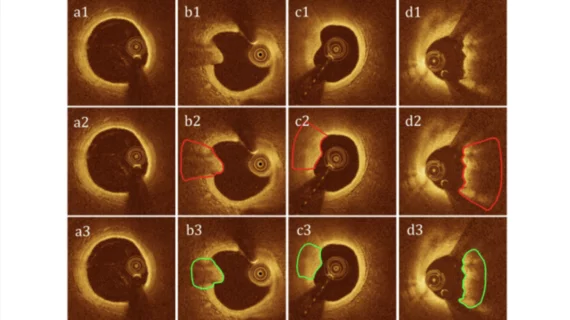New AI model detects plaque erosion in arteries
A new AI-based method to detect plaque erosion using optical coherence tomography (OCT) images offers an opportunity to easily identify a condition that blocks blood flow to the heart and can potentially cause heart attacks, according to a new study in Biomedical Optics Express.
“If cholesterol plaque lining arteries starts to erode, it can lead to a sudden reduction in blood flow to the heart known as acute coronary syndrome, which requires urgent treatment,” research team leader Zhao Wang, from the University of Electronic Science and Technology of China, said in a statement about the study.
Currently, OCT is the only clinically available imaging modality that can diagnose plaque erosion, the study notes. While helpful in many cases, OCT also presents multiple challenges. Namely, image interpretation has a high level of difficulty and significant inter-observer variability.
The AI method correctly identified 80% of plaque erosion cases that it analyzed, with a positive predictive value of 73%—similar to rates from three experienced physicians, the statement notes, while saving the time and effort associated with human analysis.
“The ability to detect plaque erosion objectively and automatically will reduce the laborious manual assessment associated with diagnosis,” Wang said.
The model works by using a neural network and shape information to predict possible regions of plaque erosion. An algorithm then refines that prediction based on clinically interpretable features, with the statement noting that this second step mimics the way that professional physicians use their knowledge to make a diagnosis.
“Our proposed method is in good agreement with physicians, and can help improve the clinical diagnosis of plaque erosion and develop individualized treatment strategies for optimal management of acute coronary syndrome patients.”
The study’s authors are working to continue improving the model’s performance by further incorporating 3D information and unlabeled data and using a larger dataset to train and evaluate the algorithm.
Reference:
1. Sun, H.; Zhao, C.; Qin, Y. et al. “In Vivo Detection of Plaque Erosion by Intravascular Optical Coherence Tomography Using Artificial Intelligence,” Biomedical Optics Express, DOI: https://doi.org/10.1364/BOE.459623
Related Content:
New blood test could help predict upcoming heart attacks or strokes
Australian tech company opens new US office, eyes FDA approval for AI CAD solution
Skip the catheterization? AI uses imaging data to ID coronary plaque blockages that require surgery
VIDEO: Getting cardiologist buy-in on artificial intelligence
